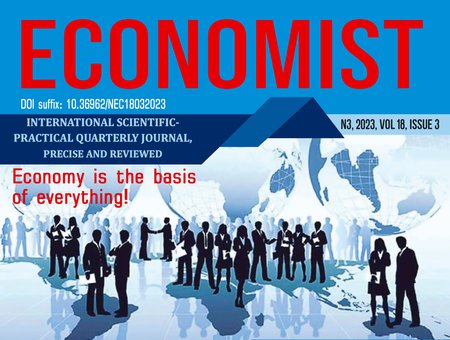GEORGIAN CONSUMERS' PERCEPTION OF BRAND PLACEMENT IN SOCIAL MEDIA

Nugzar Todua
Doctor of Economics Science, Professor and Head of Marketing Department, Faculty of Economics and Business, Ivane Javakhishvili Tbilisi State University

Giorgi robakidze
PhD candidate, Faculty of Economics and Business, Ivane Javakhishvili Tbilisi State University
Abstract
Copyright © 2023 the Author/s
Peer review method: Double-Blind
Accepted: September 9, 2023
Published: September 22, 2023
Original scientific article
DOI suffix: 10.36962/NEC18032023-16
The paper shows that modern companies actively use digital technologies to advance their products on the market. In this regard, the use of marketing strategies for product (brand) placement on social media is particularly noteworthy. In the article, based on the analysis of literary materials, the main determinants (variables) of brand placement in social media are established, among which are the acceptance of brand placement, consumer awareness of placed brands, brand recall, and electronic word-of-mouth (eWOM). Relevant items are formulated for the mentioned variables, on the basis of which the research hypotheses are formulated and the research conceptual model is developed. In order to determine the impact of the named variables on Georgian consumers, a marketing research was conducted, which included the population of Georgia over 18 years of age. A total of 654 respondents from different regions of Georgia were interviewed. The results of the study were processed using the statistical program SPSS 27. The analysis showed that the measures used in the study have a high level of reliability. The fact that Georgian consumers' views on traditional advertising are changing and they pay more attention to non-traditional methods of promotion was also shown. As such, based on the research, product placement on social media is Regression analysis was used to test the hypotheses and determine the relationship between the above-mentioned variables. As a result of such an analysis, statistically significant values have been obtained, which prove the connections between the variables related to brand placement on social media by Georgian consumers. The theoretical and practical considerations obtained as a result of the research are useful for companies operating in the Georgian market who are trying to promote their brands to local consumers through indirect advertising.
References
- Aaker, D. A. (2009). Managing brand equity. Simon and Schuster.
- Apil, A. R., Kaynak, E., and Todua, N. (2009). Product Preference Differences of High and Low Ethnocentric Consumers in Georgia. In Proceedings of the 18th World Business Congress „Management Challenges in an Environment of Increasing Regional and Global Concerns“,International Management Development Association, pp. 531-539.
- Babin, B. J., Herrmann, J. L., Kacha, M., & Babin, L. A. (2021). The effectiveness of brand placements: A meta-analytic synthesis. International Journal of Research in Marketing, 38(4), 1017-1033.
- Balakrishnan, B., Dousin, O., & Permarupan, P. (2012). The impact of brand placement and brand recall in movies: Empirical evidence from Malaysia. International Journal of Management and Marketing Research, 5(2), 39-52.
- Barnhardt, T. M., Manzano, I., Brito, M., Myrick, M., & Smith, S. M. (2016). The effects of product placement in fictitious literature on consumer purchase intention. Psychology & marketing, 33(11), 883-898.
- Bentley, K., Chu, C., Nistor, C., Pehlivan, E., & Yalcin, T. (2021). Social media engagement for global influencers. Journal of Global Marketing, 34(3), 205–219.
- Cárdaba, M. A., Fernández, A., Martinez, L., & Cuesta, U. (2023). Make it part of the story: The role of product placement prominence and integration in fashion and beauty blogs among young digital natives. Journal of Global Fashion Marketing, 14(2), 157-172.
- Chan, F. F. Y. (2020). Prior disclosure of product placement: The more explicit the disclosure, the better the brand recall and brand attitude. Journal of Business Research, 120, 31-41.
- Chan, F. F. Y., Lowe, B., & Petrovici, D. (2015). Young adults’ perceptions of product placement in films: An exploratory comparison between the United Kingdom and Hong Kong. Journal of Marketing Communications, 23(3), 311–328.
- Chavadi, C. A., Menon, S. R., & Sirothiya, M. (2019). Modelling the Effects of Brand Placements in Movies: An Investigative Study of Event Type and Placement Type. Vision, 23(1), 31-43.
- Cheung, C. M., & Thadani, D. R. (2012). The impact of electronic word-of-mouth communication: A literature analysis and integrative model. Decision support systems, 54(1), 461-470.
- Chevalier, J. A., & Mayzlin, D. (2006). The effect of word of mouth on sales: Online book reviews. Journal of marketing research, 43(3), 345-354.
- Civelek, M. E., & Ertemel, A. V. (2018). Trust building model of customers on B2c websites: A research on Generation Y customers/B2c web Sitelerinde Müşterilerin Güven Oluşturma Modeli: Y Jenerasyonu Müşterileri Üzerine Bir Araştırma. Journal of History Culture and Art Research, 7(1), 332-340.
- Coker, K. K., & Altobello, S. A. (2018). Product placements in social settings: The impact of coviewing on the recall of placed brands. Journal of Business Research, 87, 128-136.
- Daugherty, T., & Hoffman, E. (2014). eWOM and the importance of capturing consumer attention within social media. Journal of Marketing Communications, 20(1-2), 82-102.
- Davtyan, D., Cunningham, I., & Tashchian, A. (2020). Effectiveness of brand placements in music videos on viewers’ brand memory, brand attitude and behavioral intentions. European Journal of Marketing, 55(2), 420-443.
- De Veirman, M., & Hudders, L. (2020). Disclosing sponsored Instagram posts: The role of material connection with the brand and message-sidedness when disclosing covert advertising. International Journal of Advertising, 39(1), 94–130.
- European Commission (2021). Knowledge for policy. Product placement. Retrieved from: https://knowledge4policy.ec.europa.eu/glossary-item/product-placement_en#:~:text=A%20marketing%20technique%20that%20uses,%2C%20video%20games%2C%20and%20advergames
- García, A. M. (2021). Product placement as an efficient marketing tool within the media mix: The case of General Motors and Transformers. Business Research. 10(1), 224–237.
- Ghosh, M. (2022). Product placement by social media homefluencers during new normal. South Asian Journal of Marketing, 3(1), 21-37.
- Goh, K. Y., Heng, C. S., & Lin, Z. (2013). Social media brand community and consumer behavior: Quantifying the relative impact of user-and marketer-generated content. Information systems research, 24(1), 88-107.
- Gupta, P. B., & Lord, K. R. (1998). Product placement in movies: The effect of prominence and mode on audience recall. Journal of Current Issues & Research in Advertising, 20(1), 47-59.
- Hashem, A. R., Salleh, N. Z. M., Abdullah, M., & Nor, R. M. (2022). Product Placement and brand attitude development in the age of digital media with disclosure and persuasion Knowledge related to brand association. A review paper from the last decade. Journal of Positive School Psychology, 6(3), 505-523.
- Hennig-Thurau, T., Gwinner, K. P., Walsh, G., & Gremler, D. D. (2004). Electronic word-of-mouth via consumer-opinion platforms: what motivates consumers to articulate themselves on the internet?. Journal of interactive marketing, 18(1), 38-52.
- Huang, R., & Sarigöllü, E. (2012). How brand awareness relates to market outcome, brand equity, and the marketing mix. Journal of Business Research, 65(1), 92-99.
- Hudders, L. (2012). Why the devil wears Prada: Consumers’ purchase motives for luxuries. Journal of Brand Management, 19, 609-622.
- Hughes, C., Swaminathan, V., & Brooks, G. (2019). Driving brand engagement through online social influencers: An empirical investigation of sponsored blogging campaigns. Journal of Marketing, 83(5), 78–96.
- Jashi, C., & Todua, N. (2013). Behavior change through social marketing (Georgian case). In Abstract Book of World Social Marketing Conference, Toronto (pp. 95-97).
- Jasmin, N. Z. B., Puspanathan, C. A., Haris, N. I. B., Devarajoo, A. R., & Simon, S. (2023). The Impact of Brand Placement Acceptance on Consumer Purchasing Intentions: A Case Study on Perak’s State Working Adults. International Journal of Recent Advances in Multidisciplinary Topics, 4(4), 28-35.
- Kakkar, K., Nayak, A. (2019). Analysis of Product Placement in Web Series and Its Influence on Consumer Buying Behavior. Global Journal of Management And Business Research: E Marketing, 19(3), 21-27.
- Khurram, M., Qadeer, F., & Sheeraz, M. (2018). The role of brand recall, brand recognition and price consciousness in understanding actual purchase. Journal of Research in Social Sciences, 6(2), 219-241.
- Kim, D., Jang, S., & Adler, H. (2015). What drives café customers to spread eWOM? Examining self-relevant value, quality value, and opinion leadership. International Journal of Contemporary Hospitality Management, 27(2), 261-282.
- Kimmel, A. J., & Kitchen, P. J. (2014). WOM and social media: Presaging future directions for research and practice. Journal of Marketing Communications, 20(1-2), 5-20.
- Kongmanon, J., & Petison, P. (2022). What do you see and what do you recall?: Using eye tracking to understand product placement. Cogent Business & Management, 9(1), 2120263.
- Kumar, S. (2017). Influence of Product Placements in Films and Television on consumers' Brand Awareness. Archives of Business Research, 5(2), 163-179.
- Laban, G., Zeidler, C., & Brussee, E. (2020). Binge-watching (Netflix) product placement: A content analysis on different product placements in Netflix originals vs. non-Netflix originals and drama vs. comedy show. MediArXiv.
- Law, S., & Braun, K. A. (2000). I'll have what she's having: Gauging the impact of product placements on viewers. Psychology & Marketing, 17(12), 1059-1075.
- Lou, C., & Yuan, S. (2019). Influenser Marketing: How Message Value and Credibility Affect Consumer Trust of Branded Content on Social Media. Journal of Interactive Advertising, 19(1), 58-73.
- Lu, L. C., Chang, W. P., & Chang, H. H. (2014). Consumer attitudes toward blogger’s sponsored recommendations and purchase intention: The effect of sponsorship type, product type, and brand awareness. Computers in Human Behavior, 34, 258-266.
- Malhotra, N. (2010). Marketing research: An applied orientation. 6th ed., Upper Saddle River, N.J.; London: Pearson Education.
- Malik, A. & Sudhakar, B.D. (2014).Brand positioning through celebrity Endorsement-A review contribution to brand literature. International Review of Management and Marketing, 4(4), 259-275.
- Mandese, J. (2006). When product placement goes too far. Broadcasting and Cable, 12.
- Matin, A., Khoshtaria, T., & Todua, N. (2022). The Impact of Social Media Influencers on Brand Awareness, Image and Trust in their Sponsored Content: An Empirical Study from Georgian Social Media Users. International Journal of Marketing, Communication and New Media, 10(18), 88-114.
- Mohd-Nordin, M. A. S., & Baharom, S. N. (2018). A Study on Awareness of Product Placement in Malaysian Movies. Ideology Journal, 3(2), 103–108.
- Ndlela, T., & Chuchu, T. (2016). Celebrity Endorsement Advertising: Brand awareness, brand recall, brand loyalty as antecedence of South African young consumers' purchase behaviour. Journal of Economics and Behavioral Studies, 8(2), 79-90.
- Nordin, M. A. S. M., & Baharom, S. N. (2018). A Study on Awareness of Product Placement in Malaysian Movies. Idealogy Journal, 3(2), 103-108.
- Noris, A., Nobile, T. H., Kalbaska, N., & Cantoni, L. (2021). Digital fashion: A systematic literature review. A perspective on marketing and communication. Journal of Global Fashion Marketing, 12(1), 32–46.
- Ong, C. C., Santiago, C. J., & Verdejo, C. K. (2022). Product Placement in Filipino Films: An approach to Consumer Purchasing Intention. Journal of Business and Management Studies, 4(1), 179-188.
- Pancaningrum, E., & Ulani, T. (2020, January). The Effect of Product Placement on Customer Interests in Mediation by Brand Awareness. In 17th International Symposium on Management (Insyma 2020) (pp. 177-182).
- Parengkuan, V. J., Tulung, J. E., & Arie, F. V. (2020). Influence of product placement in movies and television programs towards brand recall of millennials. Jurnal EMBA: Jurnal Riset Ekonomi, Manajemen, Bisnis Dan Akuntansi, 8(1).2085-2094.
- Purwianti, L., & Niawati, N. (2022). Analysis of e-WOM, Brand Attitude, Brand Image on Purchase Intention. SEIKO: Journal of Management & Business, 5(1), 356-366.
- Puspanathan, C. A., Jasmin, N. Z., Singh, N. S. B., Lim, S. S., & Simon, S. (2020). The Influential Characteristics of Brand Placement Towards Consumers Intention to Purchase: A Study on Youth Consumer's Intentions to Purchase in Perak: Ciri-Ciri Berpengaruh Perletakan Jenama Terhadap Niat Pembelian Pengguna dalam Kalangan Orang Muda di Perak. Sains Insani, 5(1), 22-33.
- Raza, A., & Jalees, T. (2016). Measuring the effect of product placement strategy on attitudinal aspects. Pakistan Business Review, 18(3), 774-789.
- Reza Jalilvand, M., & Samiei, N. (2012). The effect of electronic word of mouth on brand image and purchase intention: An empirical study in the automobile industry in Iran. Marketing intelligence & planning, 30(4), 460-476.
- Russell, C. A., & Rasolofoarison, D. (2017). Uncovering the power of natural endorsements: A comparison with celebrity-endorsed advertising and product placements. International Journal of Advertising, 36(5), 761–778.
- Saqif, Z., & Razi, S. (2018). Brand placements in films and television: An effective marketing communication strategy to influence customers. International Journal of Management Excellence, 10(3), 1423-1433
- Saqif, Z., & Razi, S. (2018). Brand placements in films and television: An effective marketing communication strategy to influence customers. International Journal of Management Excellence, 10(3), 1423-1433.
- Song, R., Meyer, J., & Ha, K. (2015). The relationship between product placement and the performance of movies. Journal of Advertising Research, 55(3), 322-338.
- Srivastava, R. K. (2016). Promoting brands through product placement in successful and unsuccessful films in emerging markets. Journal of Promotion Management, 22(3), 281-300.
- Statista (2023). Internet and social media users in the world 2023. Retrieved from: https://www.statista.com/statistics/617136/digital-population-worldwide
- Tariq, M., Abbas, T., Abrar, M., & Iqbal, A. (2017). EWOM and brand awareness impact on consumer purchase intention: mediating role of brand image. Pakistan Administrative Review, 1(1), 84-102.
- Todua, N. (2017). Social media marketing for promoting tourism industry in Georgia. In Proceedings of the 22nd International Conference on Corporate and Marketing Communications: Challenges of Marketing Communications in a Globalized World, Zaragoza (Spain), pp. 168-171.
- Todua, N. (2019). Using social media marketing for attracting foreign tourists to Georgian destinations. Globalization & Business, 7, 39-48.
- Todua, N., & Dotchviri, T. (2015). Anova in marketing research of consumer behavior of different categories in georgian market. Annals of the Constantin Brancusi University of Targu Jiu, Economy Series, (1), 183-190.
- Todua, N., & Jashi, C. (2015). Some aspects of social media marketing (Georgian Case). International Journal of Economics and Management Engineering, 9(4), 1204-1207.
- Todua, N., & Jashi, Ch. (2018). Influence of Social Marketing on the Behavior of Georgian Consumers Regarding Healthy Nutrition. Bulletin of the Georgian National Academy of Sciences, 12(2), 183-190.
- Todua, N., & Robakidze, G. (2023a). Marketing Aspects of Product Placement and Modern Trends in its Development. Economics and Business, 15(2), 78-104.
- Todua, N., & Robakidze, G. (2023b). The Impact of Product Placement on Consumer Behaviour (Case of Georgia). International Journal of Scientific and Management Research, 6(8), 21-29.
- Tritama, H. B., & Tarigan, R. E. (2016). The effect of social media to the brand awareness of a product of a company. Communication and Information Technology, 10(1), 9-14.
- Wei, M.-L., Fischer, E., & Main, K. J. (2008). An examination of the effects of activating persuasion knowledge on consumer response to brands engaging in covert marketing. Journal of Public Policy & Marketing, 27(1), 34–44.
- Wiles, M. A., & Danielova, A. (2009). The worth of product placement in successful films: An event study analysis. Journal of marketing, 73(4), 44-63.
- Zhang, Z., Ye, Q., Law, R., & Li, Y. (2010). The impact of e-word-of-mouth on the online popularity of restaurants: A comparison of consumer reviews and editor reviews. International Journal of Hospitality Management, 29(4), 694-700.
The New Economist N 3 (2023), Vol 18, Issue 3

07/10/2023
Copyright (c) 2023 Nugzar Todua, Giorgi robakidze

This work is licensed under a Creative Commons Attribution-NonCommercial-NoDerivatives 4.0 International License.
